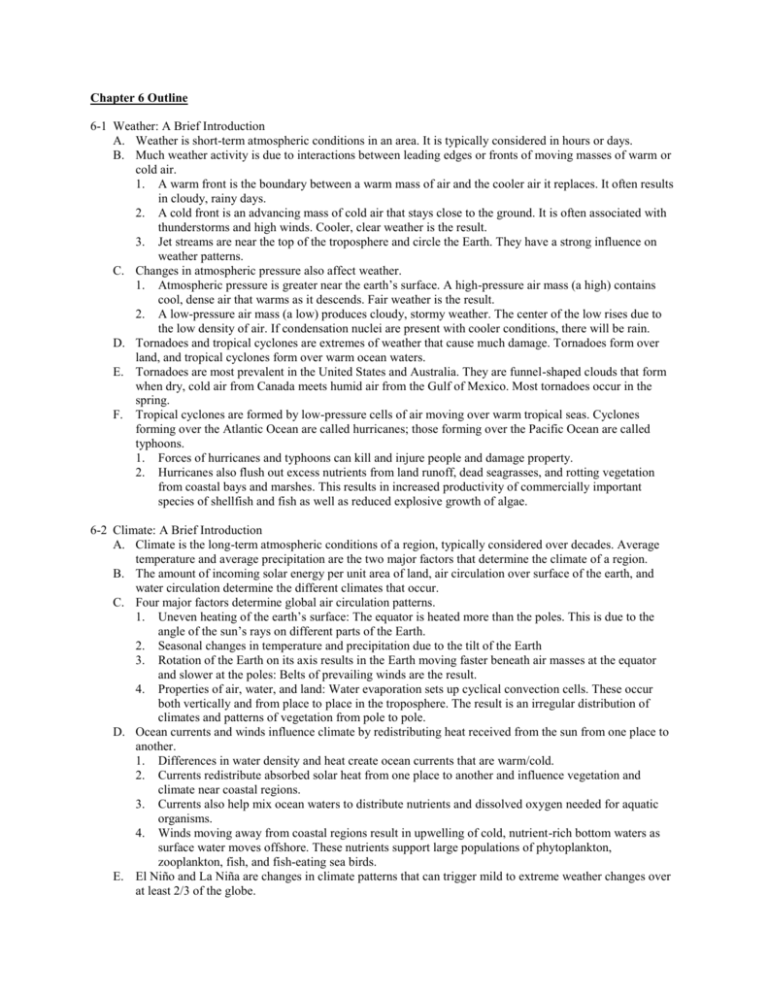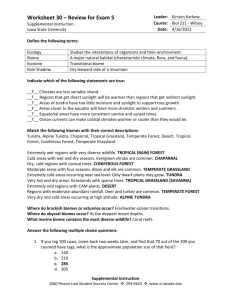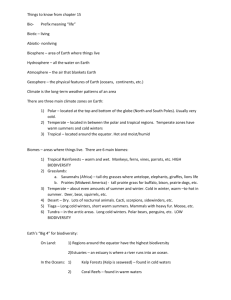Chapter 6 Outline
advertisement

Chapter 6 Outline 6-1 Weather: A Brief Introduction A. Weather is short-term atmospheric conditions in an area. It is typically considered in hours or days. B. Much weather activity is due to interactions between leading edges or fronts of moving masses of warm or cold air. 1. A warm front is the boundary between a warm mass of air and the cooler air it replaces. It often results in cloudy, rainy days. 2. A cold front is an advancing mass of cold air that stays close to the ground. It is often associated with thunderstorms and high winds. Cooler, clear weather is the result. 3. Jet streams are near the top of the troposphere and circle the Earth. They have a strong influence on weather patterns. C. Changes in atmospheric pressure also affect weather. 1. Atmospheric pressure is greater near the earth’s surface. A high-pressure air mass (a high) contains cool, dense air that warms as it descends. Fair weather is the result. 2. A low-pressure air mass (a low) produces cloudy, stormy weather. The center of the low rises due to the low density of air. If condensation nuclei are present with cooler conditions, there will be rain. D. Tornadoes and tropical cyclones are extremes of weather that cause much damage. Tornadoes form over land, and tropical cyclones form over warm ocean waters. E. Tornadoes are most prevalent in the United States and Australia. They are funnel-shaped clouds that form when dry, cold air from Canada meets humid air from the Gulf of Mexico. Most tornadoes occur in the spring. F. Tropical cyclones are formed by low-pressure cells of air moving over warm tropical seas. Cyclones forming over the Atlantic Ocean are called hurricanes; those forming over the Pacific Ocean are called typhoons. 1. Forces of hurricanes and typhoons can kill and injure people and damage property. 2. Hurricanes also flush out excess nutrients from land runoff, dead seagrasses, and rotting vegetation from coastal bays and marshes. This results in increased productivity of commercially important species of shellfish and fish as well as reduced explosive growth of algae. 6-2 Climate: A Brief Introduction A. Climate is the long-term atmospheric conditions of a region, typically considered over decades. Average temperature and average precipitation are the two major factors that determine the climate of a region. B. The amount of incoming solar energy per unit area of land, air circulation over surface of the earth, and water circulation determine the different climates that occur. C. Four major factors determine global air circulation patterns. 1. Uneven heating of the earth’s surface: The equator is heated more than the poles. This is due to the angle of the sun’s rays on different parts of the Earth. 2. Seasonal changes in temperature and precipitation due to the tilt of the Earth 3. Rotation of the Earth on its axis results in the Earth moving faster beneath air masses at the equator and slower at the poles: Belts of prevailing winds are the result. 4. Properties of air, water, and land: Water evaporation sets up cyclical convection cells. These occur both vertically and from place to place in the troposphere. The result is an irregular distribution of climates and patterns of vegetation from pole to pole. D. Ocean currents and winds influence climate by redistributing heat received from the sun from one place to another. 1. Differences in water density and heat create ocean currents that are warm/cold. 2. Currents redistribute absorbed solar heat from one place to another and influence vegetation and climate near coastal regions. 3. Currents also help mix ocean waters to distribute nutrients and dissolved oxygen needed for aquatic organisms. 4. Winds moving away from coastal regions result in upwelling of cold, nutrient-rich bottom waters as surface water moves offshore. These nutrients support large populations of phytoplankton, zooplankton, fish, and fish-eating sea birds. E. El Niño and La Niña are changes in climate patterns that can trigger mild to extreme weather changes over at least 2/3 of the globe. 1. El Niño/Southern Oscillation (ENSO) results from a change in direction of tropical winds. Trade winds blowing west are weakened or reversed. 2. Surface water warms along the North and South American coasts, and upwelling of nutrients is suppressed, which reduces primary productivity that results in a sharp decline in fish populations. 3. Jet stream above North America is also distorted, changing weather patterns. 4. La Niña cools some coastal surface waters and brings back coastal upwelling. This results in warmer, drier winters in the southeastern and southwestern U.S., wetter winters in the Pacific Northwest, rain in Southeast Asia, etc. F. Gases such as water vapor, carbon dioxide, methane, and nitrous oxide play key roles in determining the earth’s average temperatures and climate. 1. These gasses are known as greenhouse gasses. They allow mostly visible light, some infrared radiation, and ultraviolet radiation to pass through the troposphere. This natural warming is the greenhouse effect. 2. The Earth would be a cold, mostly lifeless place without this effect. 3. Human activities have added to the carbon dioxide, methane, and nitrous oxide in the atmosphere. The fear is that this can increase the natural greenhouse effect and lead to global warming. 4. Precipitation patterns, sea levels, and crop growing areas could be altered. G. Various topographic features can create local and regional climates different from the general climate of a region. 1. One example of this is the rain shadow effect, where an air mass moves inland from an ocean, reaches a mountain range, and as the air is forced to rise, cools and loses moisture on the windward side. The leeward side of the mountain will be drier due to the loss of moisture on the windward side. 2. Bricks, asphalt, and other building materials create distinct microclimates in cities that are warmer, have more haze and smog, and lower wind speeds than the countryside around them. 6-3 Biomes: Climate and Life on Land A. Different climates lead to different communities of organisms, especially vegetation. B. Differences in average temperature and precipitation due to global air and water circulation lead to differences in climate. C. Scientists divide the world into 12 major biomes. 1. Average annual precipitation, temperature, and soil type are the most important factors in producing tropical, temperate, or polar deserts, grasslands, and forests. 2. Biomes are actually a mosaic of different biological communities, but with similarities unique to the biome (forest, grassland, desert). 3. Climate and vegetation vary with latitude and altitude of an area. Latitude measures distance from the equator; altitude measures elevation above sea level. 6-4 Desert Biomes A. Deserts have little precipitation and little vegetation. They are found in tropical, temperate, and polar regions. B. Deserts cover about 30% of the earth’s land surface, mostly in tropical and subtropical regions. The largest ones are found in the interior of continents. Others form because of the rain shadow effect on the down side of mountains. 1. Tropical deserts are hot and dry most of the year with few plants, rocks, and sand. 2. Temperate deserts have high day temperatures in the summer and low temperatures in the winter, with more rain than in tropical deserts. Plants are widely spaced, mostly drought-resistant shrubs, cacti/succulents, etc. 3. Cold deserts have cold winters and warm summers with low rainfall. 4. Semi-deserts are intermediate between desert and grassland and dominated with thorn trees and shrubs adapted to long dry spells, with brief periods of sometime heavy rain. C. Survival adaptations include ways to “beat the heat” and water conservation techniques. 1. Plants may drop leaves during hot, dry spells to survive in a dormant state. 2. Plants may have no leaves, store water in fleshy tissue, and open pores for gas exchange only at night. 3. Some plants have very long tap roots to reach groundwater. 4. Evergreen plants have thick, waxy leaves to reduce evapotranspiration. 5. Annuals store biomass in seeds that may be dormant for years. 6. 7. D. 1. 2. 3. E. Most animals are small. They may only come out at night or in the early morning. Others become dormant during extreme heat or drought. Insects/reptiles have thick outer coverings to conserve water. Wastes are dry feces and concentrated urine. Deserts take a long time to recover from disturbances. Plant growth is slow. Species diversity is low. Nutrient cycling is slow, and there is a lack of water. Human impact on deserts due to overgrazing and off-road vehicles may take decades to overcome. 6-5 Grassland, Tundra, and Chaparral Biomes A. Grasslands, or prairies, have enough water to support grasses but few, if any, trees. B. They persist because of seasonal drought, grazing by large herbivores, and occasional fires that keep shrubs and trees from growing. C. The three main types of grasslands are tropical, temperate, and polar (tundra). D. A savanna usually has warm temperatures year-round and two long, dry seasons with much rain the rest of the year. 1. Large herds of grazing/browsing animals feed here. 2. There are a number of different niches in the savanna. 3. Competition for plant materials has been minimized due to specialized eating habits. 4. Many of these animals are killed for coats, tusks (ivory, for example), etc. 5. Human attempts to raise cattle on savannas may result in converting them to desert areas. Cattle need more water, so they move between water holes, causing loss of vegetation and soil compaction. 6. Cattle fecal material kills grass beneath them as they dry, while native herbivores have dry fecal pellets that readily decompose, recycling nutrients. E. Temperate grasslands have cold winters; hot, dry summers; and deep, fertile soils. F. They are widely distributed in North and South America, Europe, and Asia. Rain falls unevenly throughout the year. 1. Organic matter accumulates, producing fertile soil as aboveground plant parts die each year. 2. Soil is held in place by a network of intertwined roots. 3. Natural grasses are adapted to fire. 4. North American grasslands are tall-grass prairies and short-grass prairies. 5. Evaporation is rapid; winds blow most of the time; and fires occur in summer and fall. 6. Humans have used these lands to raise cattle and crops. They are often flat areas, easily plowed. 7. Plowing makes soil vulnerable to erosion and blowing. 8. Overgrazing of a number of areas has led to sagebrush desert instead of grassland. G. Polar grasslands, or arctic tundra, are treeless, cold plains. Long, dark winters and low precipitation are the norm. 1. There is a thick, spongy mat of low-growing vegetation (grasses, mosses, dwarf woody shrubs). 2. Most growth occurs within 6–8 weeks of summer in long days. 3. Permafrost is a permanently frozen layer of soil when water freezes. 4. Tundra is waterlogged during the summer, with hordes of insects. 5. Migratory birds nest and breed in bogs and ponds during the summer. 6. Animals are mostly small herbivores such as lemmings, hares, and voles that burrow underground to evade the cold. 7. Predators include the lynx, weasel, snowy owl, and artic fox. 8. Decomposition is slow, and soil is poor in organic matter and minerals. 9. Human activities such as oil drilling and mining have scarred the landscape, which is very slow to recover. H. Alpine tundra occurs above the tree line, but below the permanent snow line. I. This area gets more sunlight than the arctic tundra and has no permafrost. Vegetation is similar to that in the arctic tundra. J. Chaparral, or temperate shrubland, is found in coastal areas that border deserts. 1. The winter rainy season is longer than in the desert, and fog during the spring/fall reduces evaporation. 2. Low-growing, evergreen shrubs with occasional trees is the vegetation type. 3. Fires move swiftly when started in these areas. Chaparral is adapted to occasional fires. 4. 5. Humans like the climate of this biome, but risk losing homes to fire. Floods/mudslides occur after fires at times. 6-6 Forest Biomes A. Forests are found in areas with moderate to high average annual rainfall. Three main types of forests are tropical, temperate, and boreal (polar). B. Tropical rain forests are near the equator, have hot, humid conditions, and almost daily rainfall. 1. Dominant plants are broadleaf evergreens with shallow roots. 2. A dense canopy blocks most sunlight from reaching lower levels. 3. Vines often drape individual trees. 4. Epiphytes such as orchids and bromeliads are found on trunks and branches. They get nutrients from falling materials and water from humid air. 5. There is great biological diversity found in many specialized niches within the forest. 6. Most animal life is found in the sunny canopy layer of the forest. 7. Ecologists build special structures to study canopy ecosystems. 8. Tropical forests cover about 2% of the land surface but are habitats for about half the terrestrial species of Earth. 9. Very little litter is on the forest floor because of rapid recycling of dead materials. Most nutrients are stored in trees, vines, and other plants. 10. The poor soil makes these areas poor places to grow crops or graze cattle. C. Temperate deciduous forests grow in areas with moderate, average temperatures, abundant rainfall, and long, warm summers. 1. Broadleaf, deciduous trees dominate this biome. Leaves drop in the fall; trees become dormant; and new leaves grow in the spring. 2. These areas have fewer species of trees. 3. More sunlight penetrates the canopy, so there is richer diversity of ground level plant life. 4. A thick layer of leaf litter is usual due to fairly slow decomposition. It is a source of nutrients for plant growth. 5. Large predator species such as bear, wolves, wildcats, and mountain lions have been killed; deer and smaller mammals are now often the dominant species. 6. Large tracts of temperate forest have been cleared and planted with a single species of tree (tree plantations). 7. Bird species migrate to and from these areas to breed and feed. They are declining due to the loss of habitat. D. Evergreen coniferous forests/boreal forests are located in areas just south of arctic tundra around the northern sub-arctic regions of the Earth. 1. Long, dry, extremely cold winters with 6–8 hours sunlight are the norm. Summers are short with 19 hours of daily sunlight. 2. Dominant trees are coniferous (cone-bearing) spruce, hemlock, fir, cedar, and pine. 3. There is low plant diversity. 4. Decomposition is slow because of low temperatures, waxy narrow leaves, and high soil acidity. Soil is nutrient poor. 5. Acidic bogs form in the summer. 6. During the summer, birds feed on the many insects. E. Coastal coniferous forests/temperate rain forests are located along the western coast of Canada to northern California. Cool temperatures, abundant rain, and dense fog are the norm. 1. Most trees are evergreen with much moss as epiphytes and ground cover. 2. There is a dense canopy with little light reaching the forest floor. 3. Winters are mild, and summers are cool. 6-7 Mountain Biomes A. Mountains are high-elevation forested islands of biodiversity, often with dramatic changes in altitude, climate, soil, and vegetation within very short distances. 1. They are prone to erosion when vegetation is removed by natural disturbances, or manmade ones. 2. Mountains have important ecological roles such as habitats for endemic species, biodiversity, and sanctuaries for animal species driven from other habitats. 3. 4. 5. B. 1. 2. 3. They help regulate the earth’s climate, and snow peaks reflect much of the solar radiation into space. The glacier ice affects sea levels as glaciers increase or decrease in mass. Mountains play a major role in the hydrologic cycle. Mountain biomes are coming under pressure from human activities. Three general ecological lessons are seen in this study: Different climates occur as a result of air and water currents flowing over an unevenly heated planet. Different climates result in different communities of organisms, or biomes. Everything is connected.







